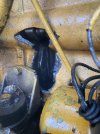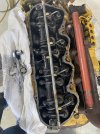A good used 3204 block shouldn't cost $3800 - and there's plenty of engines running just fine with holes in blocks that had block patches installed.
There's some good high-nickel cast-iron electrodes around that produce excellent cast iron repairs.
It simply pays to know your tractors weaknesses, and who ran it, the likely total hours, and what they were like for el-cheapo repairs that were done to sell it, not to keep it.
Both the 3204 and the 3208 are noted for having weak pistons, especially the original 2 ring design of the 70's and early 80's.
The wrist pin bushing is also a weak spot, never use anything but genuine Cat wrist pin bushings and ensure that they're installed to specifications precisely.
Even the conrod bolts are lightweight, and should be replaced when the engine is overhauled.
When the brother and I first started in business in 1964, we were young and green. The brother bought an Allis-Chalmers HD11 that showed 4000 hrs on the electric hour meter.
He was convinced by the salesman that the tractor was a great machine, and the hours were genuine.
We bought it and shortly afterwards, things started breaking right, left and centre.
We broke sprocket centres, broke brake bands, had major torque converter problems (found out later that the dealer had done a torque converter repair and left a big cleaning rag inside the oil lines!! What a mess, it tore up and got pumped through everything!).
Of course, the dealer denied any responsibility and it was impossible to prove the rag was left there by their mechanic.
The engine overheated and the entire cooling system, plus engine, needed to be rebuilt. The worn tracks gave us constant trouble with loose track pins falling out every second day!
Then we found out from a previous employee of the owner, that the owner would disconnect the HD11 hour meter for long periods! The tractor had probably done over 10,000 hours!
The final straw was when the locally-built ripper tore itself off the back end housing of the tractor!!
We spent over a week rebuilding the mounting plate, replacing broken studs, and repairing stripped bolt holes!
That tractor sure was a sharp learning curve, and we knew if we kept it, it would break us.
Part of the problem was the AC transmission design with a high-multiplication ratio, torque converter.
These AC torque converters had a multiplication ratio of up to 6 to 1 - meaning the tractor slowed down a lot under load, and the torque output went through the roof.
At stall, the old HD11 had nearly the same drawbar pull as the current Cat D8H at 1mph.
This meant the HD11 drivetrain from the torque converter back was subject to stresses it was never designed for with a direct drive transmission. We tore the spokes out of track sprockets every few months.
After 18 mths, we'd had enough of doing more wrenching than earthmoving! We had a huge backlog of work to be done, so we traded that PIA HD11 on a new Cat D6C in 1966, and we were in earthmoving heaven!!
The D6C was the most trouble-free tractor we ever owned, and we ended up buying a second new one in 1968.



